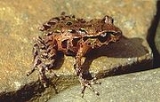
Archey's Frog
Encyclopedia
Archey's frog, Leiopelma archeyi, is a primitive frog native to New Zealand
, one of only four extant species belonging to the taxonomic family Leiopelmatidae
. It is named after Sir Gilbert Archey (1890–1974), the former Director of the Auckland Institute
. It is found only in the Coromandel Peninsula
and near Te Kuiti
in the North Island of New Zealand.
The species is fully terrestrial, living and reproducing under damp vegetation in native forests. Currently its distribution is confined to higher elevations although just 15 years ago the species was abundant even near sea level. Little is known about the natural history of this species. Although the species is sexually monomorphic, males are believed to be the primary care providers, and may prepare "nests" that they guard for the eggs, and secrete antimicrobial peptides onto them, to ensure successful embryonic development. Clutch sizes vary between 4 and 10 eggs. Reproduction is fully terrestrial; tadpoles develop within gelatinous egg capsules, and upon hatching, tailed froglets crawl onto the male's back and are carried around for several weeks. Adult frogs do not give advertisement vocalisations, but may communicate by chemical signalling. However, frogs sometimes give startle calls when threatened by a predator.
An intensively monitored population in one Cormandel site declined by 88% from 1996 to 2001 but in many areas where frogs previously were common, none remain. Because populations are rapidly declining, and reproduction is infrequent, the species is at significant risk of imminent extinction.
As first shown by Bruce Waldman, the species appears to have an intrinsic low level of susceptibility to chytridiomycosis
. However, frogs in the field show clinical signs, including blisters, that may be associated with other diseases.
A captive breeding programme was established at the University of Canterbury in 2002 to safeguard the species from disease, and frogs successfully bred. The programme was transferred to Auckland Zoo in 2005, where over half of the frogs, including juveniles bred at the Canterbury facility, died; none have since reproduced.
It is classed as Nationally Critical in the New Zealand Threat Classification System
.
New Zealand
New Zealand is an island country in the south-western Pacific Ocean comprising two main landmasses and numerous smaller islands. The country is situated some east of Australia across the Tasman Sea, and roughly south of the Pacific island nations of New Caledonia, Fiji, and Tonga...
, one of only four extant species belonging to the taxonomic family Leiopelmatidae
Leiopelmatidae
Leiopelmatidae, or New Zealand and North American primitive frogs, is a family belonging to the suborder Archaeobatrachia. Their relatively primitive form indicates that they have an ancient lineage...
. It is named after Sir Gilbert Archey (1890–1974), the former Director of the Auckland Institute
Auckland War Memorial Museum
The Auckland War Memorial Museum is one of New Zealand's most important museums and war memorials. Its collections concentrate on New Zealand history , natural history, as well as military history.The museum is also one of the most iconic Auckland buildings, constructed in the neo-classicist...
. It is found only in the Coromandel Peninsula
Coromandel Peninsula
The Coromandel Peninsula lies in the North Island of New Zealand. It is part of the Waikato Region and Thames-Coromandel District and extends 85 kilometres north from the western end of the Bay of Plenty, forming a natural barrier to protect the Hauraki Gulf and the Firth of Thames in the west...
and near Te Kuiti
Te Kuiti
Te Kuiti is a small town in the south of the Waikato region of the North Island of New Zealand. It lies at the junction of State Highways 3 and 30 and on the North Island Main Trunk Railway, 80 km south of Hamilton....
in the North Island of New Zealand.
The species is fully terrestrial, living and reproducing under damp vegetation in native forests. Currently its distribution is confined to higher elevations although just 15 years ago the species was abundant even near sea level. Little is known about the natural history of this species. Although the species is sexually monomorphic, males are believed to be the primary care providers, and may prepare "nests" that they guard for the eggs, and secrete antimicrobial peptides onto them, to ensure successful embryonic development. Clutch sizes vary between 4 and 10 eggs. Reproduction is fully terrestrial; tadpoles develop within gelatinous egg capsules, and upon hatching, tailed froglets crawl onto the male's back and are carried around for several weeks. Adult frogs do not give advertisement vocalisations, but may communicate by chemical signalling. However, frogs sometimes give startle calls when threatened by a predator.
An intensively monitored population in one Cormandel site declined by 88% from 1996 to 2001 but in many areas where frogs previously were common, none remain. Because populations are rapidly declining, and reproduction is infrequent, the species is at significant risk of imminent extinction.
As first shown by Bruce Waldman, the species appears to have an intrinsic low level of susceptibility to chytridiomycosis
Chytridiomycosis
Chytridiomycosis is an infectious disease of amphibians, caused by the chytrid Batrachochytrium dendrobatidis, a non-hyphal zoosporic fungus. Chytridiomycosis has been linked to dramatic population declines or even extinctions of amphibian species in western North America, Central America, South...
. However, frogs in the field show clinical signs, including blisters, that may be associated with other diseases.
A captive breeding programme was established at the University of Canterbury in 2002 to safeguard the species from disease, and frogs successfully bred. The programme was transferred to Auckland Zoo in 2005, where over half of the frogs, including juveniles bred at the Canterbury facility, died; none have since reproduced.
It is classed as Nationally Critical in the New Zealand Threat Classification System
New Zealand Threat Classification System
The New Zealand Threat Classification System is used by the Department of Conservation to assess conservation priorities of species in New Zealand....
.

